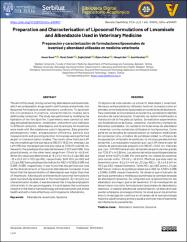| dc.contributor.author | Susar, Hasan | |
| dc.contributor.author | Çelebi, Murat | |
| dc.contributor.author | Çelebi, Çağla | |
| dc.contributor.author | Çoban, Özlem | |
| dc.contributor.author | Şen, Hüseyin | |
| dc.contributor.author | Karahan, İzzet | |
| dc.date.accessioned | 2025-01-23T06:46:23Z | |
| dc.date.available | 2025-01-23T06:46:23Z | |
| dc.date.issued | 2024 | en_US |
| dc.identifier.issn | 0798-2259 | |
| dc.identifier.uri | https://doi.org/10.52973/rcfcv-e34401 | |
| dc.identifier.uri | https://hdl.handle.net/20.500.12462/15900 | |
| dc.description | Susar, Hasan (Balikesir Author) | en_US |
| dc.description.abstract | The aim of this study is to by converting albendazole and levamisole,
which are antiparasitic drugs used in both humans and animals, into
liposomal formulations under laboratory conditions. To ascertain
the circumstance in practice, characterization studies were
additionally conducted. The study was performed by modifying the
hydration of the thin lipid film. Experiments were carried out with
egg phosphatidylcholine, cholesterol, chloroform and methanol
in different amounts. Albendazole and levamisole formulations
were made with the substances used in liposomes. Zeta potential,
polydispersity index, encapsulation efficiency, particle size
measurements and scanning electron microscopy were performed
as part of characterization studies. The results show that Lipo LVM
has the smallest particle size value at 380.87±19.52 nm, whereas Lipo
LVM–PBS has the largest particle size value at 7236.67 ±443.89 nm.
Values for the polydispersity index fall between 0.527 and 0.896. Zeta
potential levels, on the other hand, range from -7.6 mV to -46.8 mV.
While this value was determined as -8.2±0.4 mV in LD Lipo ABZ and
-18.4±0.6 mV in HD Lipo ABZ, respectively. Both HD Lipo ABZ and
LD Lipo ABZ have polydispersity indices for ABZ of 0.529±0.066 and
0.896 ±0.085, respectively. It was found that the particle size rose
as the desired amount of liposomal albendazole increased. It was
found that the liposomization of albendazole was higher than that
of levamisole. Albendazole and levamisole liposomal formulations
were successfully developed in the investigation. By carrying out
characterization studies, it was discovered that it may be employed in
clinical trials. In the upcoming years, it is anticipated that continuous
research in the field of nanotechnology will improve human and animal
health and aid to more effectively control parasite infestations | en_US |
| dc.description.abstract | El objetivo de este estudio es convertir albendazol y levamisol,
fármacos antiparasitarios utilizados tanto en humanos como en
animales, en formulaciones liposomales en condiciones de laboratorio.
Para comprobar la circunstancia en la práctica, se realizaron además
estudios de caracterización. El estudio se realizó modificando la
hidratación de la fina película lipídica. Se realizaron experimentos
con fosfatidilcolina de huevo, colesterol, cloroformo y metanol en
diferentes cantidades. Se realizaron formulaciones de albendazol
y levamisol con las sustancias utilizadas en los liposomas. Como
parte de los estudios de caracterización se realizaron mediciones
del potencial zeta, el índice de polidispersidad, la eficacia de
encapsulación, el tamaño de partícula y la microscopía electrónica
de barrido. Los resultados muestran que Lipo LVM tiene el valor de
tamaño de partícula más pequeño con 380,87± 19,52 nm, mientras
que Lipo LVM–PBS tiene el valor de tamaño de partícula más grande
con 7236,67±443,89 nm. Los valores del índice de polidispersidad se
sitúan entre 0,527 y 0,896. Por otra parte, los niveles de potencial
zeta oscilan entre -7,6 mV y -46,8 mV. Mientras que este valor se
determinó como -8,2 ± 0,4 mV en LD Lipo ABZ y -18,4 ± 0,6 mV en
HD Lipo ABZ, respectivamente. Tanto HD Lipo ABZ como LD Lipo
ABZ tienen índices de polidispersidad para ABZ de 0,529 ± 0,066
y 0,896 ± 0,085, respectivamente. Se observó que el tamaño de
partícula aumentaba a medida que aumentaba la cantidad deseada
de albendazol liposomal. Se comprobó que la liposomización del
albendazol era mayor que la del levamisol. En la investigación se
desarrollaron con éxito formulaciones liposomales de albendazol y
levamisol. Al realizar estudios de caracterización, se descubrió que
pueden emplearse en ensayos clínicos. Se prevé que en los próximos
años la investigación continua en el campo de la nanotecnología
mejore la salud humana y animal y ayude a controlar más eficazmente
las infestaciones parasitarias. | en_US |
| dc.description.sponsorship | Balikesir University Scientific Research Co-ordinatorship (BAP) 2020 / 095 | en_US |
| dc.language.iso | eng | en_US |
| dc.publisher | Universidad del Zulia | en_US |
| dc.relation.isversionof | 10.52973/rcfcv-e34401 | en_US |
| dc.rights | info:eu-repo/semantics/openAccess | en_US |
| dc.rights | Attribution-NonCommercial-ShareAlike 3.0 United States | * |
| dc.rights.uri | http://creativecommons.org/licenses/by-nc-sa/3.0/us/ | * |
| dc.subject | Albendazole | en_US |
| dc.subject | Levamisole | en_US |
| dc.subject | Liposome | en_US |
| dc.subject | Albendazol | en_US |
| dc.subject | Levamisol | en_US |
| dc.subject | Liposoma | en_US |
| dc.title | Preparation and characterisation of liposomal formulations of levamisole and albendazole used in veterinary medicine | en_US |
| dc.title.alternative | Preparación y caracterización de formulaciones liposomales de levamisol y albendazol utilizadas en medicina veterinaria | en_US |
| dc.type | article | en_US |
| dc.relation.journal | Revista Cientifica de la Facultad de Veterinaria | en_US |
| dc.contributor.department | Veteriner Fakültesi | en_US |
| dc.contributor.authorID | 0000-0002-7121-1468 | en_US |
| dc.contributor.authorID | 0000-0002-1769-2512 | en_US |
| dc.contributor.authorID | 0000-0001-6253-7346 | en_US |
| dc.contributor.authorID | 0000-0003-1154-7602 | en_US |
| dc.contributor.authorID | 0000-0001-8468-4945 | en_US |
| dc.contributor.authorID | 0000-0002-5108-7770 | en_US |
| dc.identifier.volume | 37 | en_US |
| dc.identifier.issue | 2 | en_US |
| dc.identifier.startpage | 1 | en_US |
| dc.identifier.endpage | 8 | en_US |
| dc.relation.publicationcategory | Makale - Uluslararası Hakemli Dergi - Kurum Öğretim Elemanı | en_US |




















